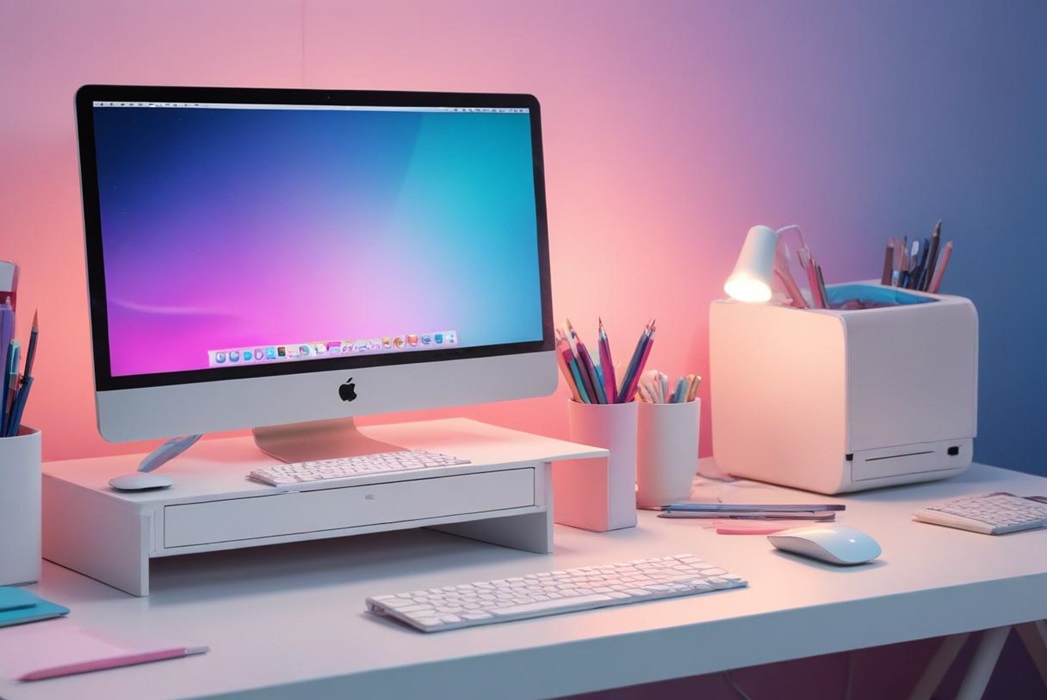Gone are the days of simply choosing between raw processing power or sleek portability- the world of computers is constantly evolving- striving to give us the best in both worlds: performance and productivity. In 2024, we’re witnessing a clear focus on artificial intelligence (AI) integration, powerful new processors, and innovative designs that prioritize both performance and portability, while making our devices more capable than ever before. The dynamic shift presents exciting opportunities for businesses to boost productivity, streamline workflows, and unlock new levels of efficiency.
So, let’s delve into some of the most exciting trends shaping desktops and ai laptops in 2024.
The Rise of AI PCs

Neural Processing Power Takes Center Stage
AI PCs are desktop or laptop computers that feature specialized hardware like neural processing units (NPUs), which are specialized chips designed specifically to accelerate AI tasks, offering significant advantages over traditional CPUs. Well, gone are the days of constant thinking and manual work, this leap in technology provides enhanced AI-powered experiences for both businesses and individuals in the real-world applications
- Smarter Assistants: Operating systems like Windows 11 now feature AI assistants like Copilot, offering proactive help and automating tasks for a smoother workflow.
- Enhanced Communication: AI-powered camera and audio features like background blur, auto-framing, and noise cancellation ensure crystal-clear video calls and presentations.
- Creative Powerhouse: AI-powered tools like dynamic backgrounds and image editing software take your creativity to the next level. Plus, AI accelerates performance in applications like Adobe Creative Cloud.
Desktops and laptops are increasingly incorporating NPUs alongside traditional CPUs. These NPUs are specifically designed to accelerate tasks like image and speech recognition, content creation, and language translation. A prime example is the Onexplayer 2 Pro (2024) by One-Netbook, which features an AMD CPU with a dedicated NPU, making it ideal for AI-powered gaming and applications.
Mainstream Adoption of AI PCs
Gartner predicts that by 2026, 100% of enterprise PC purchases will be AI PCs, up from less than 5% in 2023. AI PCs are expected to reduce the need for cloud-based AI processing, as more AI workloads can be handled on the device itself, improving performance, privacy, and offline functionality. By 2027, AI PCs are expected to make up 60% of all PCs shipped, enabling new use cases in productivity, creativity, entertainment, and more.
Examples of AI PCs by Leading Manufacturers
Acer AI PCs:
- Acer Swift Go 14 (AMD and Intel versions)
- Acer Swift Go 16
- Acer Swift X 14
- Acer Swift Edge 16
- Acer Aspire Vero 16
Other Manufacturers:
- Dell and Lenovo are offering AI PC models with the latest AI-capable processors from Intel and AMD.
- High-end gaming PCs with powerful GPUs can handle AI workloads efficiently.
- Qualcomm’s Snapdragon computer platforms power AI PCs with support for popular AI frameworks and applications.
M Series Processors and the Power Shift

Different processors for different tasks
Apple’s transition from Intel processors to its own ARM-based M series marks a significant shift in hardware strategy. These System-on-Chip (SoC) designs, now found in Macs, iPads, and other devices, lay the groundwork for a future where on-device intelligence seamlessly integrates with Apple Intelligence, the privacy-focused AI platform unveiled at WWDC 2024.
The M series’ key innovation lies in its integration of dedicated machine learning accelerators within both the CPU and GPU. This architecture facilitates efficient on-device AI processing, enabling the handling of complex AI applications while preserving user privacy and extending battery life. The neural engine tackles real-time AI tasks like voice recognition and image enhancement, while the CPU and GPU handle traditional computing and graphics functions.
The M1 and M2 chips boast 16-core neural engines capable of 11 trillion operations per second, seamlessly integrating AI into core functionalities. The newer M3 and M4 iterations take this a step further, featuring even more advanced 16-core neural engines performing a staggering 38 trillion operations per second.
All M series chips handle everyday tasks like web browsing and document editing with ease. The M3 and M4, with potentially more potent CPUs, are expected to offer smoother multitasking and excel in demanding applications like video editing and 3D rendering.
Apple plans to overhaul its entire Mac lineup with the upcoming M4 chip, further optimizing for AI. This signifies a clear commitment to building Macs that are not just powerful, but also AI-ready.
Rise of ARM Chips
A Strong Contender
For years, x86 processors dominated the desktop and laptop landscape. However, for businesses prioritizing mobility, ARM chips are making serious inroads due to their power efficiency, which makes them ideal for thin and light laptops that prioritize battery life. ARM chips are well-suited for AI applications due to their energy-efficient architecture and widespread adoption.

Companies like Microsoft are developing ARM-based Windows laptops under the “Copilot+ PC” banner, aiming to rival the efficiency of Chromebooks while offering a full Windows experience. The Ethos-U85, ARM’s most powerful and efficient NPU, delivers a 4x performance boost and 20% higher power efficiency compared to its predecessor, making it an attractive choice nor businesses seeking to equip their workforce with powerful yet portable computing solutions.
Beyond Processing Power
High-Performance Components Fuel the Future
Processor advancements are just one piece of the puzzle. High-bandwidth memory solutions like Samsung’s HBM3E 12H chip is crucial for handling the data demands of AI applications. This chip boasts a massive 36 GB capacity and industry-leading bandwidth, allowing for faster AI training and improved performance in data-intensive applications.
Additionally, advancements in graphics processing units (GPUs) from companies like AMD are pushing the boundaries of what’s possible for content creators and gamers. AMD’s latest Ryzen 780M GPU offers powerful graphics processing for demanding tasks with greater ease.
Portable Powerhouses
Compact Designs for Maximum Impact
The desire for ever slimmer and lighter devices remains strong. Laptops like the ASUS ZenBook S 13 OLED, with a remarkable 1 cm (about 0.39 in) thinness and a weight of just 1 kg, demonstrate the ability to achieve impressive thinness and lightness without compromising performance. This focus on portability empowers a mobile workforce and caters to business professionals seeking to work seamlessly while on the move.
Innovative form factors like detachable screens and foldable designs are gaining traction, offering users more versatile computing experiences.
Unique Features and Aesthetics
Transparent Laptops. Wire FREE connectivity, etc.
Innovation isn’t limited to just performance. Eye-catching designs like transparent laptops are grabbing attention. These laptops offer a glimpse into the inner workings of the machine, showcasing the creative spirit within the tech industry. While not yet mainstream, transparent laptops are a new and innovative concept being explored by companies like Lenovo.
Additionally, advancements in cable management and wireless connectivity are streamlining the user experience. Imagine a desktop with minimal cables or a laptop that charges wirelessly – these concepts are becoming a reality. The “War on Cables” trend in desktop PCs involves hardware manufacturers designing components to minimize internal cables and create a cleaner, more minimalist look inside the PC case. Some high-end laptops are starting to offer wireless charging capabilities, though this technology is still emerging.
Eco-Friendly Computing
Power Efficiency Takes Center Stage
As users become increasingly environmentally conscious, power efficiency is a major selling point. Manufacturers are focusing on components and features that minimize energy consumption. Advancements in display technology have led to more power-efficient screens, and power-efficient components and innovative cooling solutions are leading to desktops and laptops that use less energy. This benefits the environment and translates to longer battery life for laptops and lower electricity bills for desktop users.
The Future of Businesses
The year 2024 paints a picture of a future filled with intelligent personal computers. AI-powered features, powerful processors like the M series and ARM chips, and innovative designs are shaping the landscape. Businesses that embrace these trends can unlock a multitude of benefits, from enhanced productivity and improved workflows to increased employee satisfaction and a commitment to environmental responsibility.






